
Sunset Heights is a historic area in El Paso, Texas that has existed since the latter part of the 1890s. Many wealthy residents have had their houses and mansions built on this hill. Although some buildings have been renovated to their former glory, many have been neglected and have deteriorated. An organization, the Sunset Heights Improvement Association, helps neighbors on a fixed income to manage home maintenance and also sponsors an annual tour.

Edward Brickell White, also known as E. B. White, was an architect in the United States. He was known for his Gothic Revival architecture and his use of Roman and Greek designs.

The El Paso and Southwestern Railroad YMCA, also known as the Douglas YMCA, is a large brick building in Douglas, Arizona. It was listed on the National Register of Historic Places in 1984.
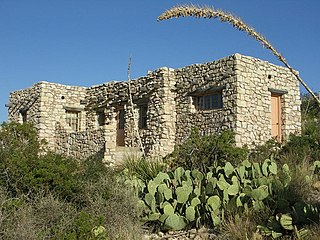
The Caverns Historic District comprises the central developed area of Carlsbad Caverns National Park. The complex was built between the early 1920s and 1942, initially in Pueblo Revival style, and later in New Mexico Territorial Revival style in the area around the natural entrance to Carlsbad Caverns. The earlier structures are built of local limestone, the later buildings in adobe. Thirteen buildings in the district are considered contributing structures. Buildings built between 1940 and 1942 were constructed with labor provided by the Civilian Conservation Corps.
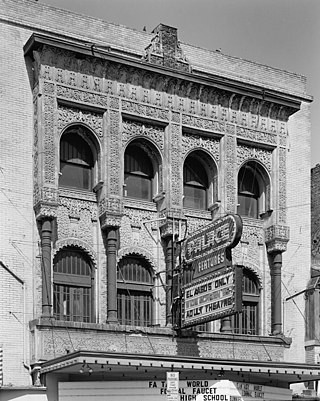
The Alhambra Theatre, also known as the Palace Theatre, is a building in El Paso, Texas. Opened on August 1, 1914, the building was designed by architect Henry C. Trost in the Spanish Colonial Revival style with a Moorish theme, preceding spread of the Moorish Revival style of the 1920s. The building cost $150,000. It was prepared to serve either as a playhouse for live theater or as a movie house, and included a large organ to be played with silent movies of the day.

The Hillsboro High School, in Hillsboro, New Mexico, is a historic Mission/Spanish Revival-style school building that was built in 1922. It was designed by El Paso–based architects Trost and Trost.

The Woman's Club of El Paso was founded in the late nineteenth century, and during that time was the only woman's organization in El Paso, Texas. The Woman's Club also allowed women in El Paso to become involved in community service and activism. The building which is the home for the club is located on 1400 N. Mesa Drive, and was erected in 1916. The club, now a non-profit organization, traces its official origins back to 1894, and continues to provide an "educational and cultural center for its members." The building is registered in the National Register of Historic Places.
Manhattan Heights is a historic district and neighborhood in El Paso, Texas. The neighborhood was added to the National Register of Historic Places in 1980.

Goddard Hall of New Mexico State University is a historic building in Las Cruces, New Mexico. It is located on S. Horseshoe between Espina and Sweet on the NMSU campus. It was listed on the National Register of Historic Places in 1988.
The Elephant Butte Irrigation District is a 6,870 acres (27.8 km2) historic district in New Mexico and Texas which was listed on the National Register of Historic Places in 1997. The listing included three contributing buildings and 214 contributing structures, in Doña Ana County, New Mexico, Sierra County, New Mexico and El Paso County, Texas.
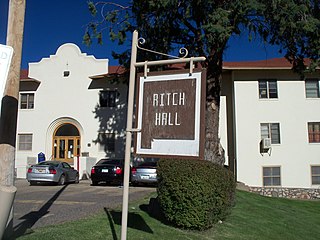
Ritch Hall is a historic building on the campus of Western New Mexico University in Silver City, New Mexico. It was built as a women's dormitory. Its construction cost $30,000, and it was completed in 1906, with remodels in 1925 and 1948. The building was named in honor of W.G. Ritch, who served as the president of the board of regents of WNMU from 1902 to 1904. It was designed in the Mission Revival style by architect Charles Frederick Whittlesey in 1906, and an extension was designed by architect John Gaw Meem in 1950. It has been listed on the National Register of Historic Places since September 22, 1988.
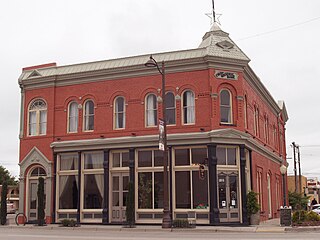
The First National Bank of Eddy is a historic building in Carlsbad, New Mexico. It was built by Caples and Hammer, a construction firm from El Paso, Texas, for the First National Bank of Eddy in 1890. Its chairman, Charles B. Eddy, was the town's namesake until it was changed to Carlsbad. The building was designed in the Late Victorian style by Ernest Krause, an architect from El Paso, Texas. It has been listed on the National Register of Historic Places since December 12, 1976.

International Boundary Marker No. 1, U.S. and Mexico is a monument on the Mexico–U.S. border, on the west bank of the Rio Grande River near El Paso, Texas. It was listed on the National Register of Historic Places in 1974 and designated as a National Historic Civil Engineering Landmark by the American Society of Civil Engineers in 1976.

Foster Hall is a historic building on the campus of New Mexico State University in Las Cruces, New Mexico. It was built in 1930 to add more classrooms on campus, and it was named for a former professor, Luther Foster, who served as NMSU's president from 1901 to 1908. The building was designed by Braunton & McGhee in the Spanish Colonial Revival and Baroque Revival architectural styles. It has been listed on the National Register of Historic Places since May 16, 1989.

The Hadley-Ludwick House is a historic house in Las Cruces, New Mexico. It was built in 1907 for Hiram Hadley, the founder of Las Cruces College, later known as New Mexico State University. The house was designed in the Colonial Revival architectural style. It has been listed on the National Register of Historic Places since April 3, 1991.
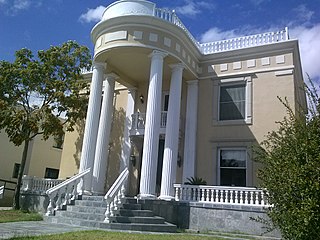
The Montana Avenue Historic District in El Paso, Texas is a historic district which was listed on the National Register of Historic Places in 2004. It includes area of 26 acres (11 ha), in the 1000 through 1500 blocks of Montana Avenue. It included 69 contributing buildings: 51 houses, two churches, and 13 garages, as well as non-contributing buildings.

The William Conroy Honors Center, at the New Mexico State University in Las Cruces, New Mexico is a historic building which is listed on the National Register of Historic Places. It was built in 1907 as a Young Men's Christian Association building. It was designed by architects Trost & Trost. It was listed on the National Register of Historic Places in 1989 with the seemingly-odd name of Air Science; it then served as the Air Science building for NMSU.

The Alameda-Depot Historic District, in Las Cruces, New Mexico, is a historic district which was listed on the National Register of Historic Places in 1985. The listing included 271 contributing buildings and a contributing site, on 70 acres (28 ha).

The Hassayampa Inn, long known as the Hassayampa Hotel, in Prescott, Arizona, is a landmark on Gurley Street which was built in 1927. It was designed by architects Trost & Trost.

Mabel Clair Vandenburg Welch was an American architect. She was the first woman to work as a professional architect in El Paso, Texas.



















